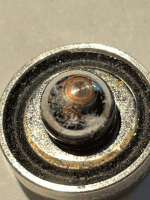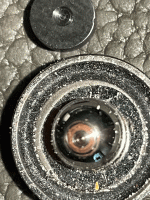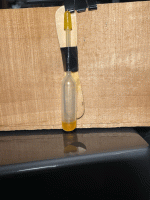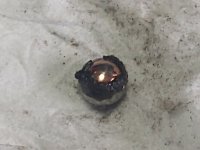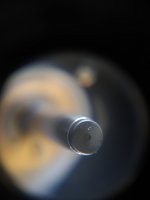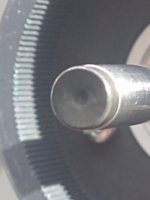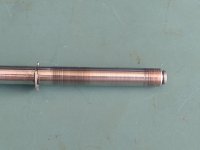I thought it was time I checked my mkII thrust bearing for wear. About 5 years ago I replaced the thrust pad with a Torlon pad from Woodsong Audio. Replacement Torlon pads seem to no longer be available from their site. I did not remove and inspect the 9/32" ball at the time so it is original. The photos show the thrust pad and ball held by a magnet for the photos. The wear on the ball is significant. I have a silicon nitride ball on order and will replace the pad and ball. There is a suggestion that Torlon can cause accelerated wear on steel balls and SiNi balls are more wear resistant.
Attachments
I recall using two types of Torlon in my bearing; Torlon 4301 and 4203. The later being the harder material. I did not test these materials over a 5 year period as you. However your images indicate some rust that has apparently accumulated around the contact area of the ball. I'm tempted to think that the rust is not being caused by the friction pad in use. Rather, I would ask about what kind of lube you had in there.I thought it was time I checked my mkII thrust bearing for wear. About 5 years ago I replaced the thrust pad with a Torlon pad from Woodsong Audio. Replacement Torlon pads seem to no longer be available from their site. I did not remove and inspect the 9/32" ball at the time so it is original. The photos show the thrust pad and ball held by a magnet for the photos. The wear on the ball is significant. I have a silicon nitride ball on order and will replace the pad and ball. There is a suggestion that Torlon can cause accelerated wear on steel balls and SiNi balls are more wear resistant.
-Steve
I saw a thread on VE where @Conrad Hoffman tested Torlon wear rates and found it wore the ball. Hopefully this will ping him and he can add his experience.
I have replaced a few thrust pads but I always replace the ball with SI3N4. My SP10 pad was replaced 2 years ago and has minimal wear spinning an 8kg platter
Every single ball I have removed has swirl marks where it was in contact with the OEM thrust pad. I have removed 2 balls that were in worse condition than the one @Bon shows in his pic.
I have replaced a few thrust pads but I always replace the ball with SI3N4. My SP10 pad was replaced 2 years ago and has minimal wear spinning an 8kg platter
Every single ball I have removed has swirl marks where it was in contact with the OEM thrust pad. I have removed 2 balls that were in worse condition than the one @Bon shows in his pic.
The orange band is not rust but where the plating is worn through. As I mentioned, the ball is original (25 Jan 1979 according to the label) so after 40+ years, some wear is expected. There is a detectable (by fingernail) ridge at the outer margin.I recall using two types of Torlon in my bearing; Torlon 4301 and 4203. The later being the harder material. I did not test these materials over a 5 year period as you. However your images indicate some rust that has apparently accumulated around the contact area of the ball. I'm tempted to think that the rust is not being caused by the friction pad in use. Rather, I would ask about what kind of lube you had in there.
-Steve
I have always used genuine Technics lube (the label has fallen off) once per year as recommended in the manual.
It would be nice to know what is going on before I replace the ball and thrust pad and button things up. The concerning question is, what happens to the material that is missing from the ball and pad? Does it result in a grinding paste that wears the shaft and journal bearing? I will be sending the bearing assembly to be assessed for wear, eccentricity etc.
Attachments
Here is a ball I pulled from an SP10 you can clearly see the copper substrate as the chrome has been totally worn away. The thrust pad was also worn completely through.
I think the lesson here is to replace the ball with SI3N4 when the pad is replaced the balls are cheap about $2US each.
I think the lesson here is to replace the ball with SI3N4 when the pad is replaced the balls are cheap about $2US each.
Attachments
Thought I'd remove the platter and check the thrust pad. One of the things you'll notice with the SI3N4 ball is the divot in the pad is very smooth, every pad I've seen running on the steel ball has ridges in the divot.
This is my pad the first pic was taken over a year ago and the second just now. This is spinning an 8kg platter, the additional wear is minimal with an addition 600+hrs of use.
This is my pad the first pic was taken over a year ago and the second just now. This is spinning an 8kg platter, the additional wear is minimal with an addition 600+hrs of use.
Attachments
OK, so I gather that the oem brg. ball is chrome plated. And that strikes me as being the problem, not the Torlon. Just order a higher quality bearing ball. Perhaps a tool steel bearing ball with a hardness of HRC 59 or higher. These are commnly available at various sources. I recall experimenting with SI3N4. But not over a lengthy period.
At this point I am not inclined to point the finger at the Torlon as the cause for deterioration. Any brg ball that has plating should not be put to use on these projects regardless of friction pad material.
-Steve
At this point I am not inclined to point the finger at the Torlon as the cause for deterioration. Any brg ball that has plating should not be put to use on these projects regardless of friction pad material.
-Steve
Is there a procedure to remove the ball from its seat without damaging anything, but above all how can it be easily inserted without denting it?
Does the sphere offer much resistance to the exit and subsequently to the entrance?
What tools are used?
Does the sphere offer much resistance to the exit and subsequently to the entrance?
What tools are used?
To remove the ball unscrew the cap, you might need to apply a bit of heat with a blowtorch or heatgun to release the thread lock. I use wood dowel to punch the ball out, this will not damage the sleeve. I put the cap in a vice with aluminium jaws and rotate the motor housing.
To re-install the ball put it on the bottom of the sleeve and screw the cap on, the cap will re-seat the ball. The cap will screw on by hand. Once the ball is seated unscrew the cap and I use Loctite 222 on the tread and screw the cap back on.
To re-install the ball put it on the bottom of the sleeve and screw the cap on, the cap will re-seat the ball. The cap will screw on by hand. Once the ball is seated unscrew the cap and I use Loctite 222 on the tread and screw the cap back on.
OK, so I gather that the oem brg. ball is chrome plated. And that strikes me as being the problem, not the Torlon. Just order a higher quality bearing ball. Perhaps a tool steel bearing ball with a hardness of HRC 59 or higher. These are commnly available at various sources. I recall experimenting with SI3N4. But not over a lengthy period.
At this point I am not inclined to point the finger at the Torlon as the cause for deterioration. Any brg ball that has plating should not be put to use on these projects regardless of friction pad material.
-Steve
It certainly looks that way, I've had 2 where the copper was visible, both came form the same radio station and the pads were worn through. Both have damaged sleeves and one a damaged spindle see pic.
Attachments
I guess my one sample wasn't the worst of the lot. I have seen a number of photos of other SP10 mkII units with the thrust pad worn completely through.
I get the impression that the materials Technics used were not really as good as they should have been. Consider that this motor unit outputs a large amount of instantaneous torque. And the shaft size , all the way out to the spindle pin, is the same. 9/32" dia. (.2813") Without intervening maintenance to the bearing, this model will literally tear its bearing to pieces.
https://www.theanalogdept.com/images/spp6_pics/User510/sp10mkII/sp10mkii_brg/DSC_0211.jpg
They've changed the way you include images into the reply lately. I see no way to drop an image from my web page into this reply, so I offer a link to the image above....which shows the bearing thrust the way I found it after I had purchased the thing.
-Steve
I get the impression that the materials Technics used were not really as good as they should have been. Consider that this motor unit outputs a large amount of instantaneous torque. And the shaft size , all the way out to the spindle pin, is the same. 9/32" dia. (.2813") Without intervening maintenance to the bearing, this model will literally tear its bearing to pieces.
https://www.theanalogdept.com/images/spp6_pics/User510/sp10mkII/sp10mkii_brg/DSC_0211.jpg
They've changed the way you include images into the reply lately. I see no way to drop an image from my web page into this reply, so I offer a link to the image above....which shows the bearing thrust the way I found it after I had purchased the thing.
-Steve
All the units I’ve seen with severely worn thrust pads also had signs of improper lubrication. proper lubrication later won’t necessarily stop the progression once abrasive debris is at the interfaces.
On the other hand I’ve seen units that looked to have untold hours of radio station use on them where the thrust pads and bearings were no worse for wear.
On the other hand I’ve seen units that looked to have untold hours of radio station use on them where the thrust pads and bearings were no worse for wear.
@steve. Interesting that the size of your thrust pad wear scar is similar to the one in my photo in #2122. The banding is almost identical to mine. A similar amount of wear I conclude. Are there any pictures of your ball?I guess my one sample wasn't the worst of the lot. I have seen a number of photos of other SP10 mkII units with the thrust pad worn completely through.
I get the impression that the materials Technics used were not really as good as they should have been. Consider that this motor unit outputs a large amount of instantaneous torque. And the shaft size , all the way out to the spindle pin, is the same. 9/32" dia. (.2813") Without intervening maintenance to the bearing, this model will literally tear its bearing to pieces.
https://www.theanalogdept.com/images/spp6_pics/User510/sp10mkII/sp10mkii_brg/DSC_0211.jpg
They've changed the way you include images into the reply lately. I see no way to drop an image from my web page into this reply, so I offer a link to the image above....which shows the bearing thrust the way I found it after I had purchased the thing.
-Steve
To remove the ball unscrew the cap, you might need to apply a bit of heat with a blowtorch or heatgun to release the thread lock. I use wood dowel to punch the ball out, this will not damage the sleeve. I put the cap in a vice with aluminium jaws and rotate the motor housing.
To re-install the ball put it on the bottom of the sleeve and screw the cap on, the cap will re-seat the ball. The cap will screw on by hand. Once the ball is seated unscrew the cap and I use Loctite 222 on the tread and screw the cap back on.
excellent thanks, I had already tried in the past to remove the bottom cap with a heat gun and it had worked ... I think this way of proceeding is the most correct.
https://www.theanalogdept.com/images/spp6_pics/User510/sp10mkII/sp10mkii_brg/DSC_8445editsanno.jpg@steve. Interesting that the size of your thrust pad wear scar is similar to the one in my photo in #2122. The banding is almost identical to mine. A similar amount of wear I conclude. Are there any pictures of your ball?
Above link to photo that shows oem ball and thrust side by side.
https://www.theanalogdept.com/images/spp6_pics/User510/sp10mkII/sp10mkii_brg/DSC_6303.jpg
Above link to photo that shows ball still in the bore after removing the bottom cap from the bearing.
As regards the bearing ball, I could find no visible evidence of wear without strong magnification. So the photos of the ball tend to show reflections around the room but no evidence of wear. I'll set up the microscope later today or tomorrow and see if I can find any trace evidence of wear.
Hope this is useful.
-Steve
Look for bullseye on the mating surface of the ball. In your pic of the OEM thrust pad the bullseye is clearly visible. I've seen this on every ball I've removed to varying degrees.https://www.theanalogdept.com/images/spp6_pics/User510/sp10mkII/sp10mkii_brg/DSC_8445editsanno.jpg
Above link to photo that shows oem ball and thrust side by side.
https://www.theanalogdept.com/images/spp6_pics/User510/sp10mkII/sp10mkii_brg/DSC_6303.jpg
Above link to photo that shows ball still in the bore after removing the bottom cap from the bearing.
As regards the bearing ball, I could find no visible evidence of wear without strong magnification. So the photos of the ball tend to show reflections around the room but no evidence of wear. I'll set up the microscope later today or tomorrow and see if I can find any trace evidence of wear.
Hope this is useful.
-Steve
IMO as the thrust pad wears it increases wear on the ball as is evident in the worn ball I posted. Most of the ball was running on the OEM pad which wore away the chrome. The increased wear was most likely increased by poor lubrication and contaminants caused by both the worn pad and ball.
The best preventative maintenance is to remove the journal (rotor) yearly, clean out the bearing well and re-lubricate. When I replace a pad and ball I always flush the journal sleeve and clean it so there is no evidence of contamination, re-install a new ball oil and journal. I ran a cotton tip around the ball in my SP10 yesterday and there was evidence of contamination. This is obviously debris from the slight wear on the thrust pad, if this contamination left in the well then it must increase wear.
I got to thinking that a tool steel thrust pad running on a SI3N4 ball might be the best option.....
Honestly I don't see any wear pattern anywhere on that ball. And it is the one I removed from the TT. The largest problem I had getting a photograph of that ball were the reflections. They masked everything.Look for bullseye on the mating surface of the ball. In your pic of the OEM thrust pad the bullseye is clearly visible. I've seen this on every ball I've removed to varying degrees.
IMO as the thrust pad wears it increases wear on the ball as is evident in the worn ball I posted. Most of the ball was running on the OEM pad which wore away the chrome. The increased wear was most likely increased by poor lubrication and contaminants caused by both the worn pad and ball.
The best preventative maintenance is to remove the journal (rotor) yearly, clean out the bearing well and re-lubricate. When I replace a pad and ball I always flush the journal sleeve and clean it so there is no evidence of contamination, re-install a new ball oil and journal. I ran a cotton tip around the ball in my SP10 yesterday and there was evidence of contamination. This is obviously debris from the slight wear on the thrust pad, if this contamination left in the well then it must increase wear.
I got to thinking that a tool steel thrust pad running on a SI3N4 ball might be the best option.....
-Steve
- Home
- Source & Line
- Analogue Source
- The Incredible Technics SP-10 Thread
